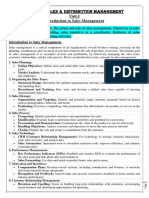0% found this document useful (0 votes)
23 views15 pagesModule One and Two Sales Management
Sales management is a critical business discipline focused on applying sales techniques and managing sales operations to achieve revenue goals. It encompasses planning, organizing, directing, and controlling sales activities while fostering customer relationships and motivating the sales team. The sales department plays a vital role in generating revenue, managing customer interactions, and collaborating with marketing to optimize sales strategies.
Uploaded by
tvelazeezCopyright
© © All Rights Reserved
We take content rights seriously. If you suspect this is your content, claim it here.
Available Formats
Download as DOCX, PDF, TXT or read online on Scribd
0% found this document useful (0 votes)
23 views15 pagesModule One and Two Sales Management
Sales management is a critical business discipline focused on applying sales techniques and managing sales operations to achieve revenue goals. It encompasses planning, organizing, directing, and controlling sales activities while fostering customer relationships and motivating the sales team. The sales department plays a vital role in generating revenue, managing customer interactions, and collaborating with marketing to optimize sales strategies.
Uploaded by
tvelazeezCopyright
© © All Rights Reserved
We take content rights seriously. If you suspect this is your content, claim it here.
Available Formats
Download as DOCX, PDF, TXT or read online on Scribd
/ 15























































































